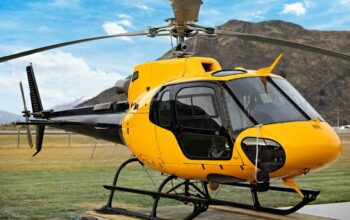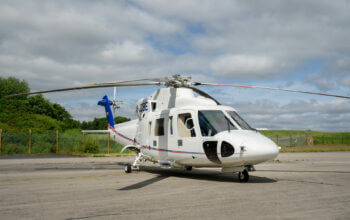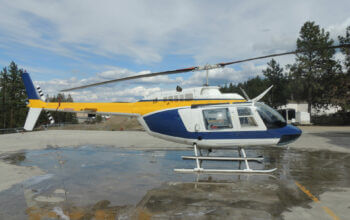This sponsored article was created by Insight magazine, the sponsored content division of MHM Publishing, on behalf of Bluedrop Training & Simulation.

“It’s one thing to tell them, but once they go in the simulator and grab the cable with the helicopter moving with the wind, they get completely immersed and forget they’re in a simulator,” said Jean-Claude Siew, executive vice president of technology and simulation at Bluedrop Training & Simulation Inc. “They come out sweating from the near-real experience.”
In a real-life hoist rescue, helicopter pilots generally can’t see the situation below them. The rescue involves critical, complex procedures and equipment amidst wind, rain, sea spray, and aircraft rotorwash in high-risk locations, such as a sinking vessel with many snag points for the hoist cable. Pilots rely largely on guidance from the hoist operator.
“You can imagine the close communication that’s needed,” Siew said.
“The person at the back is actually telling the pilot where to go because he can see the situation — [it’s] real teamwork.”
Yet, the first time a rescue operator hoists in these dangerous environments is often during live operations, as there has never been a training device that can provide the multi-variable complexity representative of search-and-rescue (SAR) hoisting.

With its new Hoist Mission Training System (HMTS), Bluedrop has changed that. The system brings to helicopter rear crews the reality simulation scenarios that pilots have benefited from for decades.
“Pilots have had high-fidelity simulators but that has not been the case for rear crews and more specifically, for hoist operators,” Siew said.
“When you think about it, their work can be as dangerous as the pilot’s. When they’re saving people off a sinking ship or a mountain cliff, it’s not always blue skies and nice weather. Now we have the technology — a very high-fidelity hoisting system — and on top of that we can connect to a flight simulator so that the two teams can work collectively. That makes our system quite unique.”
He said other systems don’t offer such high degrees of fidelity.

“For example, the cable can be just an elastic band so you don’t have any feel, or the cable just goes up and down,” Siew said. “In our case, the cable also varies its tension depending on what is hanging out — say a basket with an injured person, or two people — or if you’re bringing up some equipment, the tension will be different.”
The cable also moves in 3D — in and out of rotor wash, with winds, sideways, or front to back.
“You need to be able to properly simulate that,” he said. “The person can act on the cable — they’re not just a spectator.”
Siew said most people are skeptical at first about how realistic the HMTS is, but “you need to try it — that’s one thing we found is that you can’t just tell people.”
And clearly the demand is there. Bluedrop recently sold two to the California Department of Forestry and Fire Protection (Cal Fire) — the first to a U.S. state government agency.
“And in Canada, we have two with the RCAF [Royal Canadian Air Force] — one on the East Coast in Shearwater, Nova Scotia, for the Cyclone, and one on the West Coast in Comox, B.C., for the Cormorant.”

Another is in St. John’s, Newfoundland, for Cougar helicopters — this one is fully integrated with the pilot simulator.
Bluedrop is also currently looking at the European market for offshore energy applications and SAR, and has formed a partnership with a U.K. company for the purpose.
And similar to how pilots have training packages, Bluedrop is selling training packages with the HMTS. Each is adaptable to the mission.
“We have them for mountain area missions, or for Cougar in St. John’s where they operate mainly over water,” Siew said. “For oil-and-gas operations, we reproduce that kind of environment with oil rigs, ships, and so on.”
Training packages are also available for SAR or combat rescue — the latter adds a new dimension to the simulation.
“We did a combat version for the USAF [U.S. Air Force],” Siew said. That involved integration of a gunnery system to protect the rescue operation. “What we are perfecting now is the capability to connect three pieces: the flight deck trainer for the pilot, the hoist trainer, and the gunnery trainer, so they can all work together.”

Siew said Bluedrop’s HMTS is the first in the world, now used by operators of multiple helicopter types, including the new Sikorsky HH-60W combat rescue helicopter, the Bell Boeing CV-22 Osprey, the Sikorsky S-92, the Boeing CH-47 Chinook, and others.
A portable version of the HMTS that can be moved from one training center to another is also available. That’s important for organizations like Cal Fire that are committed to training and safety, allowing them to maximize employment of assets for training.
Bluedrop’s suite of simulation products help teach mission-critical skills in a completely safe, yet true-to-life environment that responds to land, air or sea dynamics and operator inputs — providing substantial cost-savings over live training.









